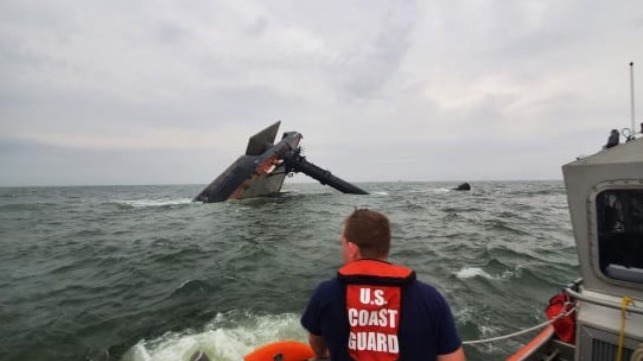Coast Guard Concludes Hearing into Loss of Seacor Power

The Coast Guard and National Transportation Safety Board concluded the formal public hearing proceedings into the sinking of the liftboat Seacor Power. During two weeks of testimony ranging from survivors to the rescuers, US Coast Guard, National Weather Service, the owners of the vessel Seacor Marine and the charterer Talos Energy, the joint investigation board reviewed and considered evidence related to the loss of the vessel on April 13, 2021.
“Today marks the conclusion of this public hearing, but it does not mark the end of our work as a Marine Board of Investigation,” said Marine Board of Investigation Chairwoman Capt. Tracy Phillips, U.S. Coast Guard. “We will continue to collect and review any evidence that may be submitted in the future. We will also begin our transition to the analysis phase of this investigation, and then later start compiling our report. “
The Coast Guard and the National Transportation Safety Board are conducting independent investigations into the circumstances that led up to the deadliest accident at sea off the Louisiana coast in decades. Thirteen of the nineteen crew and contractors aboard the vessel were lost. The board also plans to make recommendations designed to reduce the risk of similar accidents in the future.
The testimony concluded this week looking at some of the more contentious issues that have been raised by the survivors and the families of the crew lost aboard the Seacor Power. Representatives from both Seacor Marine and Talos Energy went before the board that was seeking to determine the role of the owner and charterer in the operations and decisions made about the operations of the vessel.
Talos Energy told the board that it had no role in determining when the vessel left port saying that it was up to the captain to provide safe navigation. They said they did not make a determination on when the vessel departed and on many occasions vessels they chartered were delayed for example by winter storms. Similarly, Seacor Marine said it consulted with the captain who expressed no reservation before the departure. Seacor told the board that there were no incentives for the captain to maintain a set schedule.
The inquiry also sought to explore the roles played by the different organizations and it seemed during the hearings that there was confusion during the response to the accident. Talos said that it had offered assistance including two dive boats that it planned to hire but they were rejected by the Coast Guard as not being properly equipped. Donjon-Smit Salvage said it had started immediately and was hired to provide divers but that it was determined with the Coast Guard that the weather conditions were too bad to enter the liftboat for two days. Talos contended that its offers were rebuffed by the Coast Guard which told them it “had it under control.”
Rescuers described frantic efforts and taking it upon themselves immediately after the accident in an attempt to save the crew from the Seacor Power. Bristow Group, a private organization that provided airlift services to the companies, said it took it upon itself and tried to save three people it saw clinging to the vessel. Private crafts also scoured the seas and did help in finding some survivors.
The weather played a central part in the testimony. The National Weather Service detailed the warnings it had issued. The Coast Guard’s admission that its warning system was offline was downplayed by the companies. They said the captain had a variety of tools and the Internet available and that it was the captain’s responsibility.
American Bureau of Shipping also spoke at the hearing. They reviewed regulations and safety requirements for the operators of liftboats.
The board heard from a total of 31 witnesses, who provided testimony into the conditions influencing the vessel prior to and at the time of the casualty. Testimony also focused on weather, training, the Seacor Power’s condition, owner and operator organizational structures and culture, the regulatory compliance record of the vessel, Coast Guard policy, and practices related to vessel design, engineering, and inspections.
Additionally, 230 pieces of evidence were identified as exhibits of public record regarding the investigation.
“On behalf of the entire board, I'd like to express our deepest condolences to the friends, shipmates, and families of the mariners who were lost during this accident,” said Capt. Phillips. “Our investigation can’t change the outcome of this tragic event, but our team is determined to examine every aspect of the incident, to push for any needed changes to enhance maritime safety and to prevent similar casualties from occurring in the future.”
The board will compile its findings into a report which will be publicly released. The NTSB is also expected to issue an independent report on the accident.
In addition to the investigation, more than a dozen lawsuits have been filed in federal and state courts by the survivors and family members. The suits also center around the role of Seacor and Talos with many families saving the vessel was unsafe and departed on the instructions of the owners and charterer.
